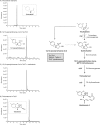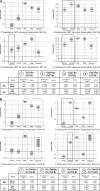Involvement of Trichoderma trichothecenes in the biocontrol activity and induction of plant defense-related genes
- PMID: 22562989
- PMCID: PMC3416386
- DOI: 10.1128/AEM.00385-12
Involvement of Trichoderma trichothecenes in the biocontrol activity and induction of plant defense-related genes
Abstract
Trichoderma species produce trichothecenes, most notably trichodermin and harzianum A (HA), by a biosynthetic pathway in which several of the involved proteins have significant differences in functionality compared to their Fusarium orthologues. In addition, the genes encoding these proteins show a genomic organization differing from that of the Fusarium tri clusters. Here we describe the isolation of Trichoderma arundinaceum IBT 40837 transformants which have a disrupted or silenced tri4 gene, a gene encoding a cytochrome P450 monooxygenase that oxygenates trichodiene to give rise to isotrichodiol, and the effect of tri4 gene disruption and silencing on the expression of other tri genes. Our results indicate that the tri4 gene disruption resulted in a reduced antifungal activity against Botrytis cinerea and Rhizoctonia solani and also in a reduced ability to induce the expression of tomato plant defense-related genes belonging to the salicylic acid (SA) and jasmonate (JA) pathways against B. cinerea, in comparison to the wild-type strain, indicating that HA plays an important function in the sensitization of Trichoderma-pretreated plants against this fungal pathogen. Additionally, the effect of the interaction of T. arundinaceum with B. cinerea or R. solani and with tomato seedlings on the expressions of the tri genes was studied.
Figures







Similar articles
-
Effects of Trichothecene Production on the Plant Defense Response and Fungal Physiology: Overexpression of the Trichoderma arundinaceum tri4 Gene in T. harzianum.Appl Environ Microbiol. 2015 Sep;81(18):6355-66. doi: 10.1128/AEM.01626-15. Epub 2015 Jul 6. Appl Environ Microbiol. 2015. PMID: 26150463 Free PMC article.
-
Relevance of trichothecenes in fungal physiology: disruption of tri5 in Trichoderma arundinaceum.Fungal Genet Biol. 2013 Apr;53:22-33. doi: 10.1016/j.fgb.2013.02.001. Epub 2013 Feb 27. Fungal Genet Biol. 2013. PMID: 23454546
-
Production of trichodiene by Trichoderma harzianum alters the perception of this biocontrol strain by plants and antagonized fungi.Environ Microbiol. 2015 Aug;17(8):2628-46. doi: 10.1111/1462-2920.12506. Epub 2014 Jun 3. Environ Microbiol. 2015. PMID: 24813508
-
Trichodiene Production in a Trichoderma harzianum erg1-Silenced Strain Provides Evidence of the Importance of the Sterol Biosynthetic Pathway in Inducing Plant Defense-Related Gene Expression.Mol Plant Microbe Interact. 2015 Nov;28(11):1181-97. doi: 10.1094/MPMI-06-15-0127-R. Epub 2015 Oct 16. Mol Plant Microbe Interact. 2015. PMID: 26168138
-
Trichothecenes and aspinolides produced by Trichoderma arundinaceum regulate expression of Botrytis cinerea genes involved in virulence and growth.Environ Microbiol. 2016 Nov;18(11):3991-4004. doi: 10.1111/1462-2920.13410. Epub 2016 Jul 15. Environ Microbiol. 2016. PMID: 27312485
Cited by
-
Trichoderma longibrachiatum TG1 increases endogenous salicylic acid content and antioxidants activity in wheat seedlings under salinity stress.PeerJ. 2022 Nov 29;10:e12923. doi: 10.7717/peerj.12923. eCollection 2022. PeerJ. 2022. PMID: 36530412 Free PMC article.
-
Tri11, tri3, and tri4 genes are required for trichodermin biosynthesis of Trichoderma brevicompactum.AMB Express. 2018 Apr 17;8(1):58. doi: 10.1186/s13568-018-0585-4. AMB Express. 2018. PMID: 29667033 Free PMC article.
-
The importance of chorismate mutase in the biocontrol potential of Trichoderma parareesei.Front Microbiol. 2015 Oct 27;6:1181. doi: 10.3389/fmicb.2015.01181. eCollection 2015. Front Microbiol. 2015. PMID: 26579090 Free PMC article.
-
A new species of Trichoderma hypoxylon harbours abundant secondary metabolites.Sci Rep. 2016 Nov 21;6:37369. doi: 10.1038/srep37369. Sci Rep. 2016. PMID: 27869187 Free PMC article.
-
Entomopathogenic Fungus-Related Priming Defense Mechanisms in Cucurbits Impact Spodoptera littoralis (Boisduval) Fitness.Appl Environ Microbiol. 2023 Aug 30;89(8):e0094023. doi: 10.1128/aem.00940-23. Epub 2023 Jul 13. Appl Environ Microbiol. 2023. PMID: 37439674 Free PMC article.
References
-
- Ahn IP, Lee SW, Suh SC. 2007. Rhizobacteria-induced priming in Arabidopsis is dependent on ethylene, jasmonic acid, and NPR1. Mol. Plant Microbe Interact. 20: 759– 768 - PubMed
-
- Alexander NJ, McCormick SP, Blackburn JA. 2008. Effects of xanthotoxin treatment on trichothecene production in Fusarium sporotrichioides. Can. J. Microbiol. 54: 1023– 1031 - PubMed
-
- Ausubel FM, et al. ( ed). 1987. Current protocols in molecular biology. John Wiley & Sons, Inc, New York, NY
-
- Baldwin C, Bycroft BW, Dewick PM, Gilbert J, Holden I. 1985. Biosynthesis of trichothecene mycotoxins in Fusarium culmorum cultures. Z. Naturforsch. C 40: 514– 518 - PubMed
Publication types
MeSH terms
Substances
LinkOut - more resources
Full Text Sources

